Agile teams have a great number of retrospectives at their disposal to evaluate their sprints and team work. One of the most popular ones is the Mad Sad Glad retro. What makes this particular retrospective different from the rest is that it focuses a lot on the emotions that team members had during the sprint.
In this article, we are going to examine the Mad Sad Glad retrospective in more detail and show you some Mad Sad Glad retrospective examples to help you understand its significance. Keep reading.

What Is a Mad Sad Glad Retrospective
The Mad Sad Glad is a retrospective that differs from the other agile retro techniques. In reality, it is a method that asks team members to recount their emotional journey during the sprint. Therefore, the finished graph shows what made each individual mad, sad, and glad.

In more detail, the Mad Sad Glad template includes the following columns:
- Mad – in the first section, the team member states all the things that made him feel angry and even hindered their overall performance.
- Sad – the next column of the Mad Sad Glad retrospective contains all the things that made the team member feel frustrated and disappointed.
- Glad – the final part of the Mad Sad Glad retro focuses on the positive aspects of the project. This means that the individual mentions the things that made them feel happy and gave them motivation to be productive.
Benefits of a Mad Sad Glad Retrospective
In the Mad Sad Glad retrospective examples, you will notice that team members have the chance to express all of their feelings. This has many benefits as it promotes communication and strengthens the bond between team members. However, we need to mention that you mustn’t include any solutions to the Mad Sad Glad retrospective template. This is another step that happens after the Mad Sad Glad retrospective.
Therefore, the advantages of the Mad Sad Glad are the following:
- Help team members become attuned to their emotions – to create the Mad Sad Glad retrospective, team members need to think about the sprint and recognize all the emotions they felt. Furthermore, they need to put these feelings into words, a thing that they might not have done if not asked to do that.
- Address complaints between team members – in the Mad Sad Glad retrospective template, team members can also express all the things that disappointed them. In the long run, this will help them cooperate better as they will avoid making the same mistakes.
- Improve the way your team operates – knowing what your team members feel will help you improve the way the team operates. You will understand the areas that need more work and put the effort into fixing them.
- Find the root causes of the tension in your team – sometimes it isn’t apparent what is causing tension during the daily tasks. Therefore, the Mad Sad Glad is a great opportunity to dig deeper to uncover the underlying issues.
- Create a safe environment for everyone – the end goal of the Mad Sad Glad retrospective is to create a safe environment for everyone, where they can express their feelings and keep feelings happy and motivated.
When to Use a Mad Sad Glad Retrospective
As you can see, the Mad Sad Glad retrospective examples focus on your team’s well-being and emotional stability, rather than productivity. Therefore, you should use a Mad Sad Glad retrospective template whenever you feel like your team members’ morale is at a low point or might be affected by some upcoming changes.
We would recommend that you use a Mad Sad Glad retrospective template in the following scenarios:
- At the end of the sprint: the Mad Sad Glad retrospective can help you evaluate how the project went. Therefore, by running it at the end of the sprint, you can uncover how the process made team members feel for future consideration.
- What you are planning on implementing some strategy changes: if you are thinking of making some changes that will alter the daily tasks, then it’s a good opportunity for this retro technique.
- When you want to reformat the team: one of the best Mad Sad Glad retrospective examples is when you are trying to change the organization of your team. With this retrospective, you will find out the tension between team members and find out how to reformat the team for better results.
- When the project seems stuck: sometimes, emotions can impact the way the team operates. Therefore, if the project seems stuck, then you can examine the well-being of your team members.
5 Mad Sad Glad Retrospective Examples
Below, we are going to give you several Mad Sad Glad retrospective examples that will give you an idea of what to expect from this agile retro method.
Mad Sad Glad Retrospective Example – 01
One of the Mad Sad Glad retrospective examples that you might encounter is the one that you will see at the end of a sprint. In this case, there weren’t any changes within the team dynamics or the process. Therefore, the Mad Sad Glad retro allows you to evaluate the emotional impact of the existing process.
Mad
- Too many daily tasks,
- The scrum tool wasn’t user-friendly.
Sad
- I had to frequently work overtime to finish the workload,
- I didn’t get the chance to use my coding skills.
Glad
- We used the idea I pitched during the brainstorming session.
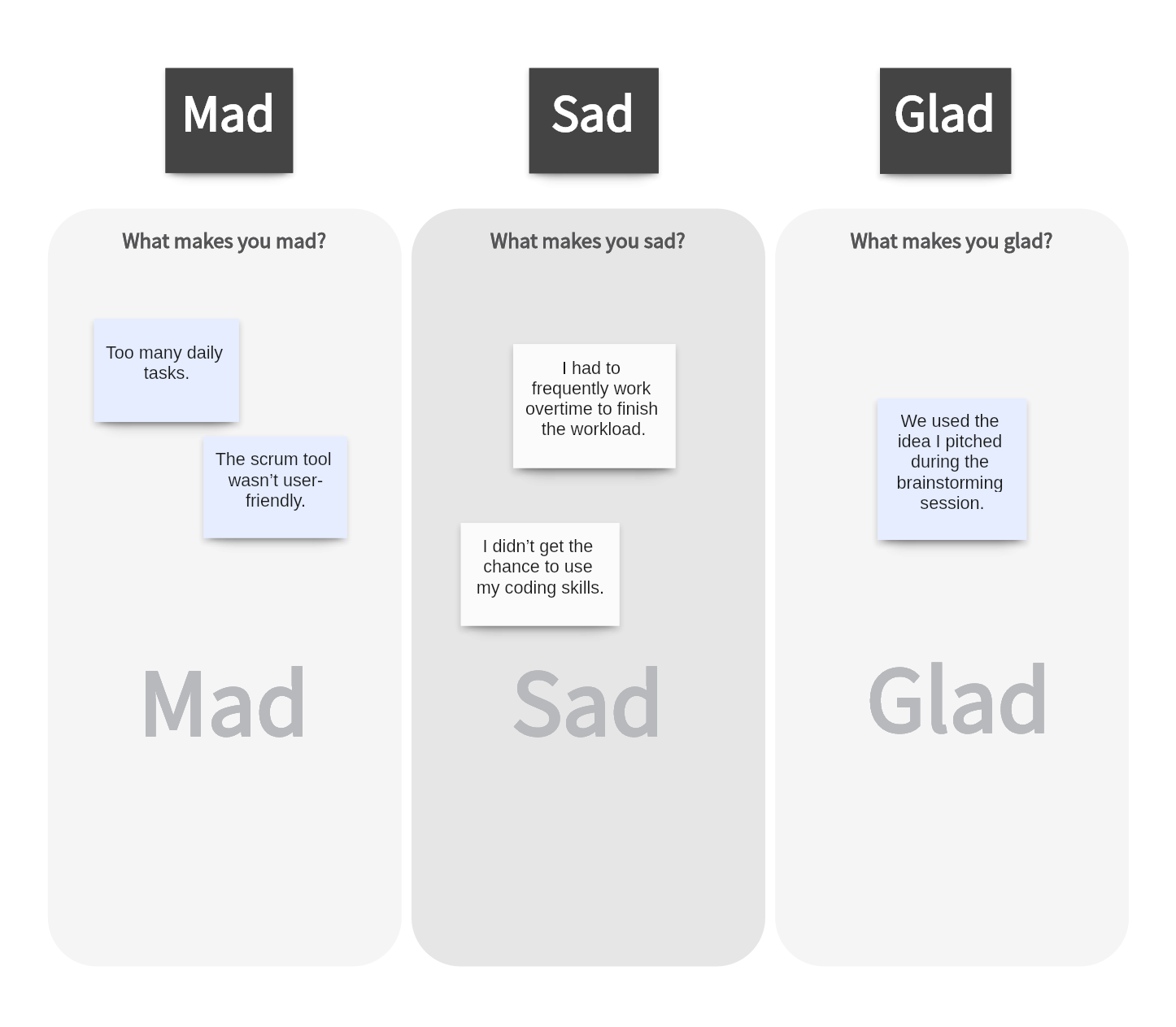
Mad Sad Glad Retrospective Example – 02
Another instance of the Mad Sad Glad retrospective comes right after a merger. In this case, the team’s dynamics and organization have changed. Therefore, as a team manager, you should use this Mad Sad Glad retrospective template to find out how the sprint with the new team went.
Mad
- We lost so much time explaining the tasks to the new team members,
- Needed to attend too many meetings to get everyone on board.
Sad
- Some of my previous team members changed departments or left the company,
- I felt that my voice wasn’t heard enough by the new members.
Glad
- The new members brought much-needed expertise,
- My daily workload was reduced.

Mad Sad Glad Retrospective Example – 03
The next Mad Sad Glad example comes from a team, where the process has changed. This might have happened because they have implemented new technologies or the management wants to try a new strategy.
Mad
- The UI of the new software was confusing, thus making me lose time,
- The new tasks felt a bit abstract at times.
Sad
- I had to attend training during my off time and weekends,
- The team leader couldn’t answer my questions about the new software.
Glad
- I collaborated closely with my coworkers.
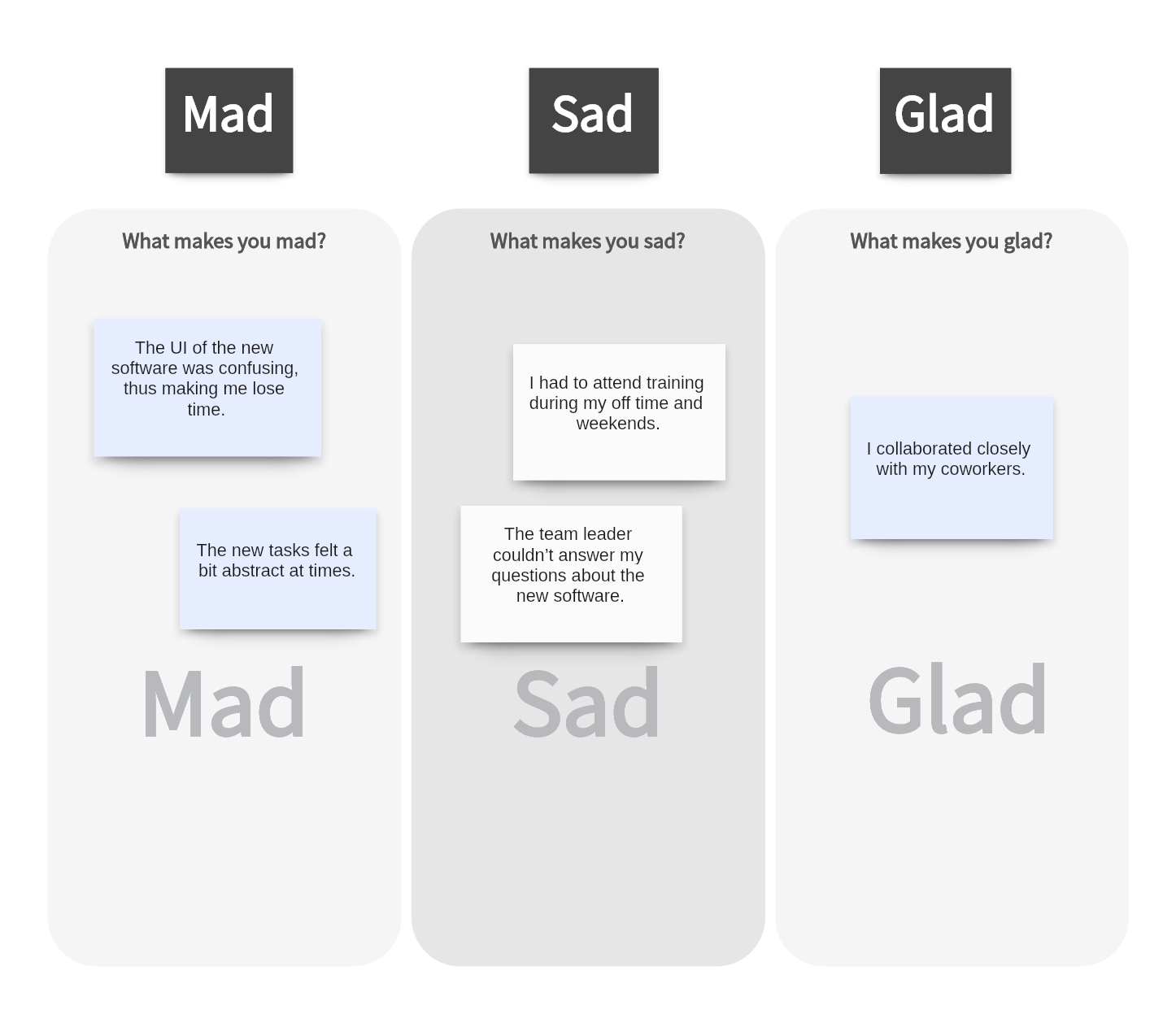
Mad Sad Glad Retrospective Example – 04
In the following Mad Sad Glad retrospective template, we are taking a look at a team member that has joined the team during the sprint.
Mad
- I needed more meetings to understand the team’s strategy,
- I made some mistakes because the brief was insufficient.
Sad
- I had few responsibilities and couldn’t show my skills.
Glad
- The existing team members were very welcoming.
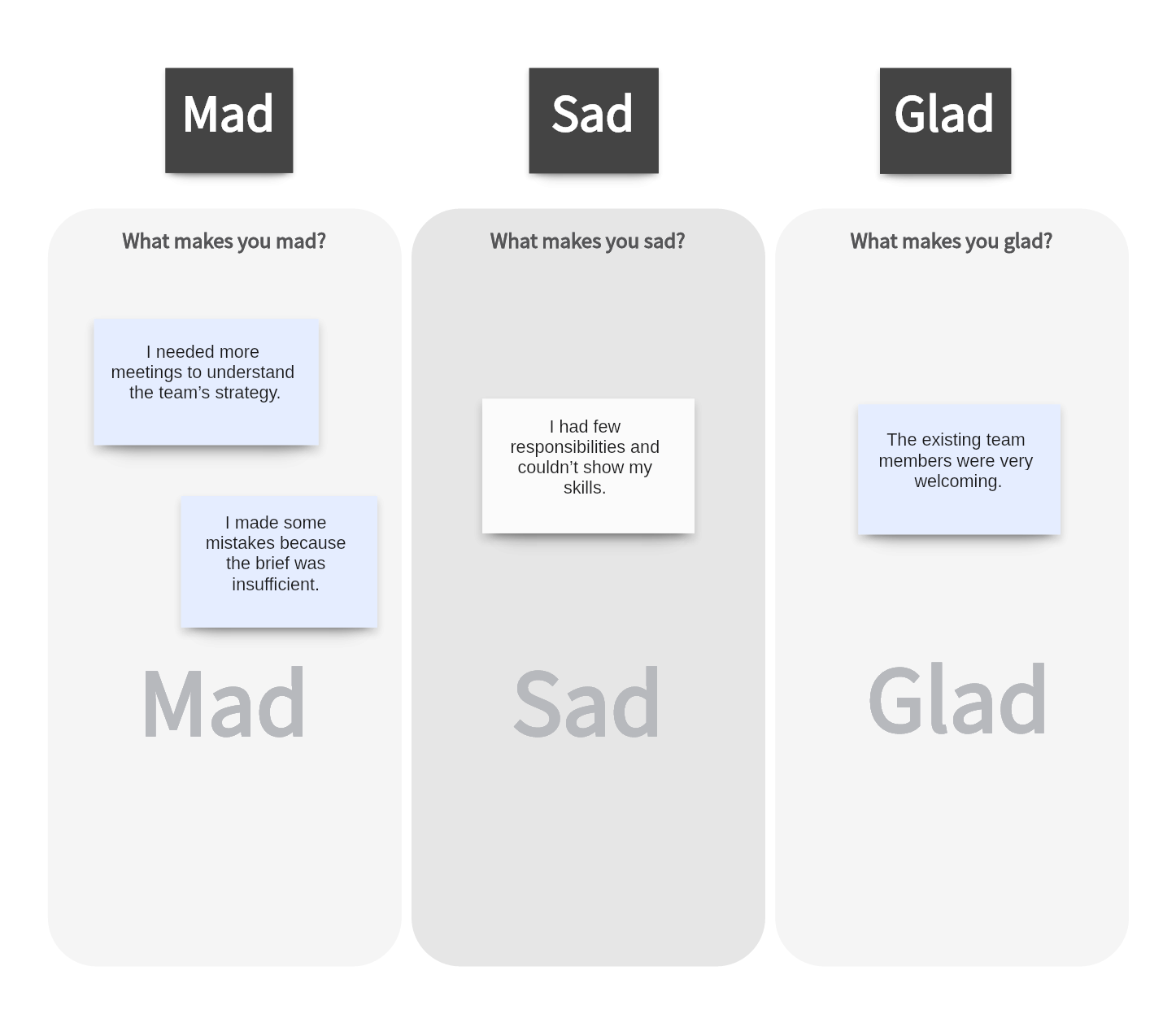
Mad Sad Glad Retrospective Example – 05
The final of the Mad Sad Glad retrospective examples we will see is from a team that has only changed management. Therefore, team members needed to adjust to a new leadership style.
Mad
- I was suddenly charged with numerous additional tasks.
Sad
- I needed to quickly learn a new skill, which made me work overtime.
Glad
- The new project leader communicated his thoughts effectively,
- I was paired to work with the members I liked the most.

A Ready-made Mad Sad Glad Retrospective Template
In the Mad Sad Glad retrospective examples we have included above, it becomes obvious that this technique digs deep into the emotional state of the team. Therefore, if you are interested in taking advantage of the Mad Sad Glad, you can start planning on running one. Finding a well-designed Mad Sad Glad retrospective template will make the process quicker and more efficient. In Boardmix, we have included a Mad Sad Glad retrospective template in our library so that you don’t have to worry about designing one from scratch.
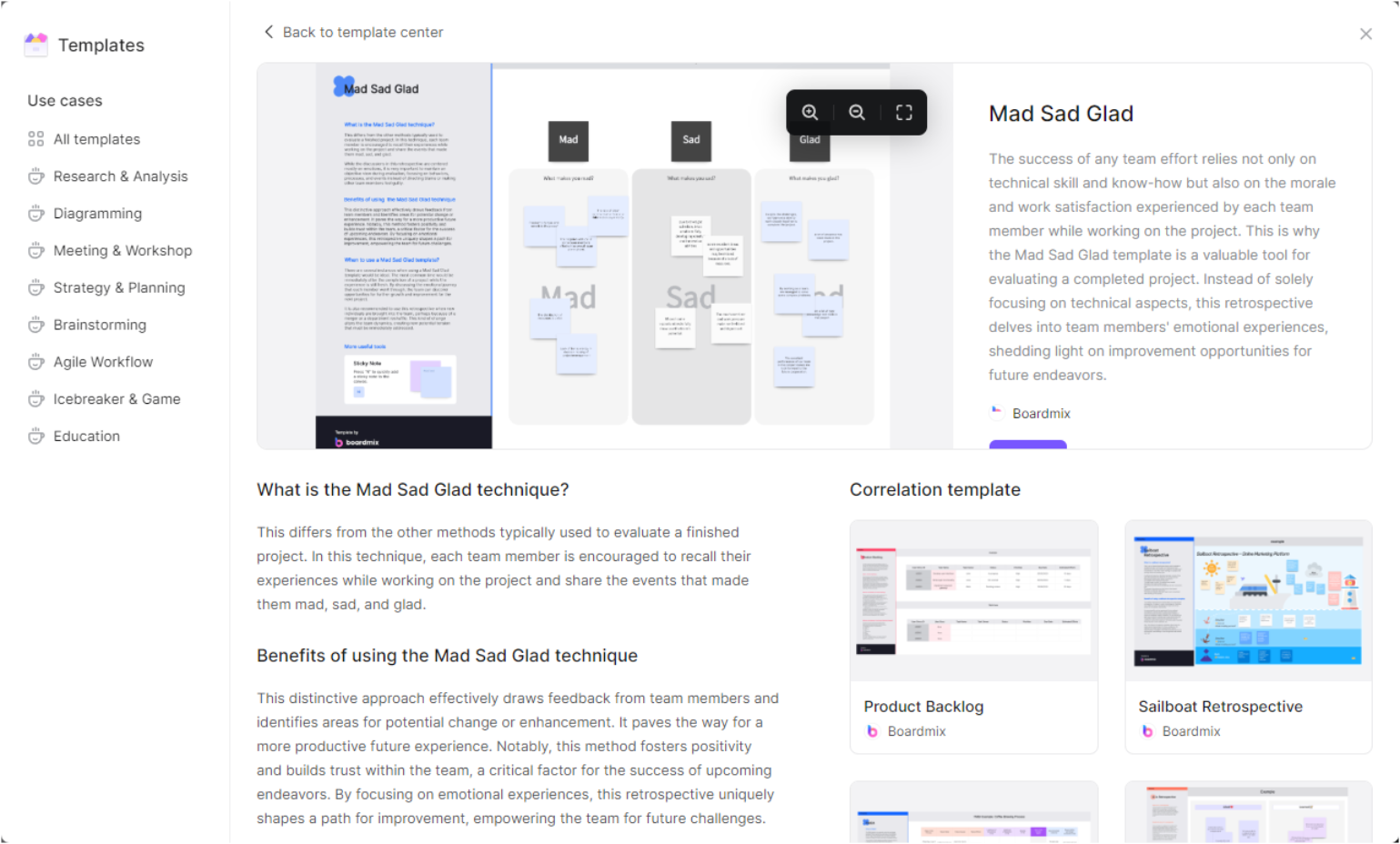
How to Run a Mad Sad Glad Retrospective with Template
After taking in the Mad Sad Glad retrospective examples, you can run this agile retro method for your team. The process of running a Mad Sad Glad retrospective becomes easy if you follow these simple steps:
Step 1 – Take advantage of Boardmix’s ready-made Mad Sad Glad retrospective template. The tool provides you with a rich library of templates, including one for Mad Sad Glad.

Step 2 – Make any changes you’d like on the template and then share the Mad Sad Glad retrospective with your team members. You can do that by clicking the Share button at the top of the screen.

Step 3 – Invite your team members to a video meeting or use the chat function on Boardmix.
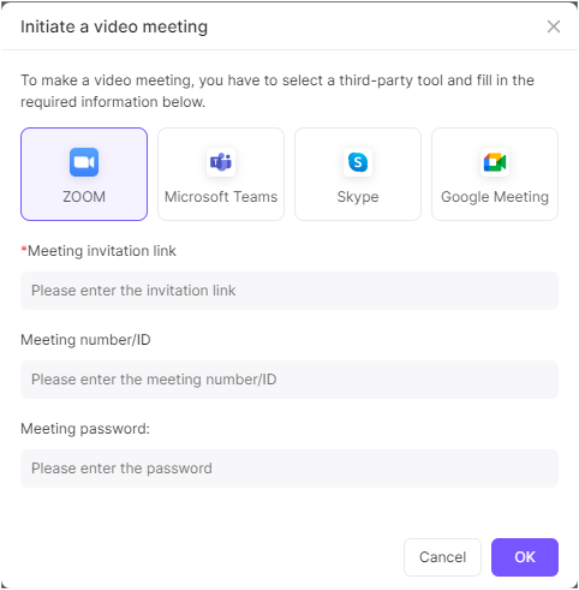
Step 4 – Start the meeting with some icebreaker questions, and then, move on to the Mad Sad Glad questions.
Step 5 – Give time to your team members to write down their answers on sticky notes that they can place in the corresponding columns. All changes in Boardmix become visible in real-time.
Step 6 – The Mad Sad Glad retrospective is automatically saved to your workspace. In addition to this, you can immediately share it with everyone involved, the management, and the shareholders. Moreover, you can save it as a PDF or any other file format that suits you.
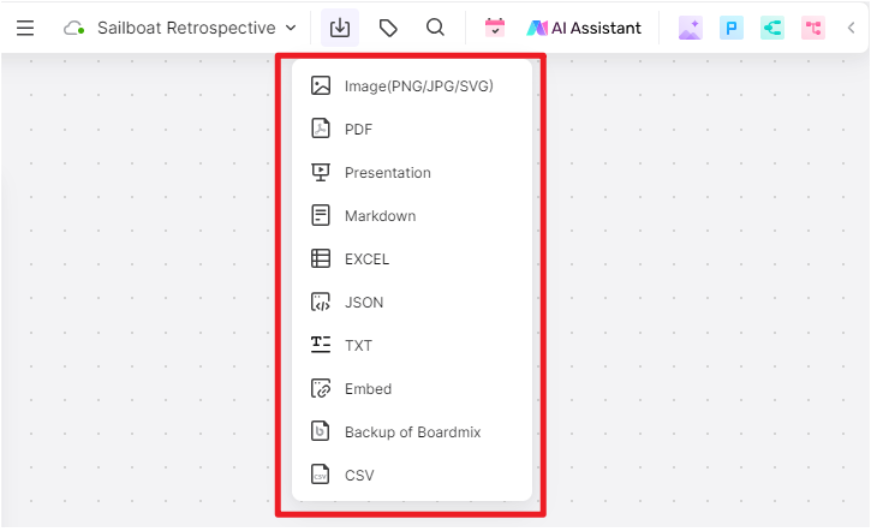
The Bottom Line
Study these Mad Sad Glad retrospective examples to find out the potential of the agile technique. With Boardmix, you have access to all the functions you might need to run a Mad Sad Glad retrospective smoothly. Try the online collaborative tool today and strengthen the bond of your team.













